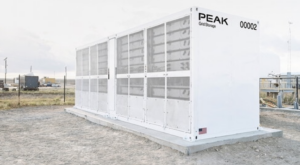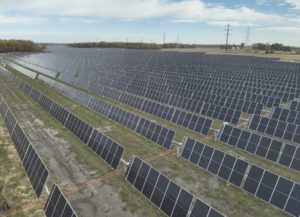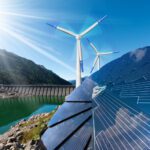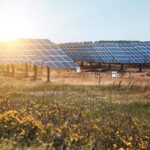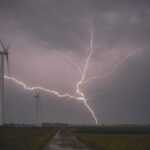Stowing capabilities, tougher modules, and real-time data are the new frontline in solar’s fight against extreme weather.
Alex Roedel and Jyoti Jain, Nextracker
The global climate crisis is reshaping the way we think about energy resilience. As extreme weather increases, utility-scale solar projects face a new era of challenges. Advanced solar tracker systems, control and monitoring software, and smart resilience strategies are pivotal to keeping projects operational as the climate evolves.
Images of solar installations devastated by hail or twisted by high winds are becoming more common. In the aftermath of Hurricane Milton in October 2024, footage of solar projects ravaged by tornadoes spread across social media, raising questions about PV’s resilience to extreme weather. Critics argue that such events expose vulnerabilities in solar technology, but the truth is more nuanced.
Understanding Increased Risk
Solar’s rapid growth into new geographies brings increased exposure to extreme weather events. According to the Solar Energy Industries Association and Wood Mackenzie’s Solar Market Insight report, the U.S. installed more than 50 GW of capacity in 2024, a 21% increase from the previous year—an impressive leap forward that also highlights the growing need for robust weather mitigation strategies.
Hurricanes, like Milton, are growing larger as they are fueled by warming waters in the Gulf of Mexico. Previously, only a handful of sites might have been affected by a storm; now, entire regions of solar farms are at risk during a single event.
Hail poses another growing threat. Research from Northern Illinois University found that global warming is likely to produce larger, more destructive hailstones, increasing the risk to solar assets. Hail damage already accounts for a significant portion of weather-related losses at PV sites—more than 50% of one major insurer’s solar loss claims—and this figure could rise as the climate changes.
Within the solar industry, certain technology trends are compounding the risks. For example, the transition to n-type TOPCon cell technology has boosted performance but requires dual-glass encapsulation to reduce moisture. While this offers benefits, the thinner, semi-tempered glass used in large-format modules is more vulnerable to extreme weather impacts. These modules need better risk reduction strategies.
Geographically, solar development is expanding into areas with higher exposure to adverse weather. In 2023, Texas and Florida led the U.S. in newly installed solar capacity—two regions particularly prone to extreme weather. Texas, a major hub for utility-scale solar, frequently faces severe hailstorms, while Florida contends with hurricanes for roughly half of the year. Solar now accounts for 7.25% of Texas’ energy mix, ranking #1 for U.S. solar capacity (>37.7 GW), according to SEIA. In 2023, Texas had a large number of hail events, according to the National Oceanic and Atmospheric Administration (NOAA), and major hailstorms in Texas increased by 93% over the past three years. As solar reaches more diverse climates, traditional weather risk assessments, based on historical data, are no longer sufficient.
The New Responsibility
Ensuring that solar projects remain resilient against extreme weather is a shared responsibility between component manufacturers; engineering, procurement, and construction (EPC) contractors; and project developers. With the expected lifespan of solar projects now extending from 25 to 40 years, the durability bar has been raised. Solar installations today are expected to withstand more extreme weather events than ever before.
Yet, the stakes go beyond the financial impact on the solar asset owners. These storms can have real negative effects on the people living in the local communities, cutting off their supply of clean, affordable electricity.
Solar’s New Extreme Weather Playbook
Solar’s continued growth has been fueled by technological innovation, and this same spirit of advancement is now being applied to weather resilience. A combination of smart hardware, adaptive software, and responsive services is enabling solar projects to withstand extreme conditions more effectively than in the past (Figure 1).
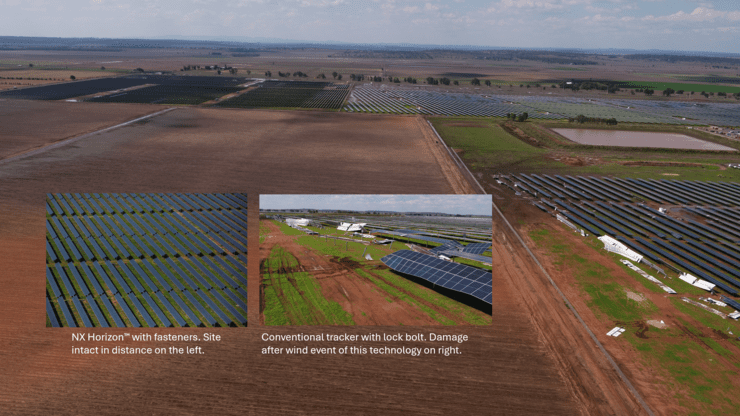
Some solar trackers, for example, offer dynamic stow angles that adjust based on real-time weather conditions. Whether it’s high winds or hail, these trackers can optimize stow angle to minimize damage. A key feature of these systems is their ability to vary stow angles across a site, accounting for both complex weather patterns and diverse land contours.
The resilience capabilities of trackers are bolstered by an uninterruptible power supply (UPS) for each row, ensuring stow functions remain operational even during grid failures. The 60-degree stow angle reduces hail impact by 40%, compared to the more common 50-degree angle.
In 2022, a hailstorm with whiteout conditions hit the Prospero 1 and Prospero 2 solar farms in west Texas. The hailstones ranged from two to three inches in diameter. The panels were stowed at a 60-degree angle, which was the steepest available setting. After the storm, the panels had almost no damage in areas of the solar farms that got hit with two-inch hail. About one-third of the panels had damage in areas with three-inch hail.
Since then, VDE Americas reviewed the storm data and concluded the damage probability could have been reduced almost to zero if the panels had been stowed at a 75-degree angle instead. In high-hail-risk regions, employing a 75-degree stow delivers an 83% reduction in hail impact (Figure 2).

Real-Time Data
Mitigating weather risks hinges on real-time data and predictive analytics. Trackers can integrate onsite weather stations with third-party data providers to create informed stow strategies, deploying them rapidly when severe weather is expected. This enables operators to respond quickly and decisively, potentially saving millions in damage repair costs.
Speed is critical, and trackers with faster rotation capability provide a significant advantage. Automation further reduces risk, with stow commands being issued automatically in response to incoming threats, eliminating the need for manual intervention across large fleets of solar projects.
After each weather event, data is collected, reported, and analyzed, enabling continuous improvement in both software algorithms and physical tracker designs. By closing the loop on real-world performance data, project operators can refine their response strategies.
Wider Insurance Benefits
The proactive approach to weather resilience doesn’t just benefit project owners and operators—it also helps insurers. With increasing payouts due to extreme weather, insurers are eager to support projects that prioritize resilience. Between 2018 and 2023, hail damage accounted for more than 54% of total losses in solar projects, according to insurer GCube, which is pushing for stronger risk mitigation practices.
In regions such as Texas, weather events causing more than $1 billion in damage are becoming more common, according to data from the National Centers for Environmental Information. The ability to demonstrate a clear return on investment (ROI) for advanced weather strategies, through reduced downtime and lower insurance premiums, makes these technologies attractive to investors and financiers alike.
Industry-Wide Effort
While the advances in tracker technology and weather resilience strategies are promising, they represent just the beginning of the required broader industry effort. As climate change continues to push the boundaries of extreme weather, the solar industry must respond with innovation and collaboration.
Ongoing real-world testing, such as Nextracker’s partnership with the National Renewable Energy Laboratory (NREL), which examines wind dynamics, is essential to developing new durability standards that go beyond current benchmarks. Data sharing across the industry is equally important, allowing stakeholders to learn from each other’s successes and failures to better prepare for the future.
Although we can’t stop extreme weather, we can mitigate its impact. Through advanced tracker technology, real-time data integration, and industry collaboration, the solar industry can continue to grow, even in the face of a changing climate.
—Alex Roedel is vice president of Design and Engineering and Jyoti Jain is the head of Software Product Management at Nextracker, a provider of intelligent, integrated solar tracker and software solutions used in utility-scale and ground-mounted distributed generation solar projects around the world.




